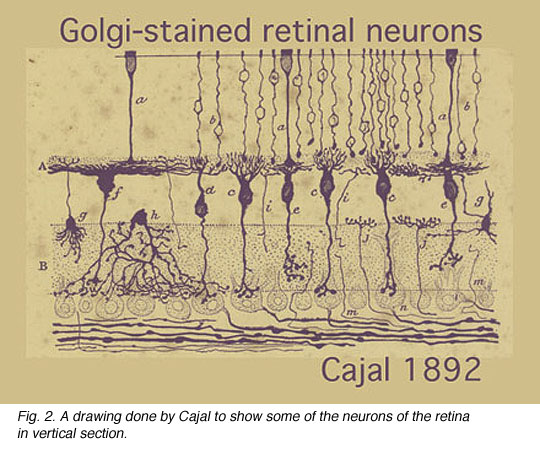| | 15.
and it's a bit boring. Neuroscience is a study of the nervous system, of the brain.
What we know about the brain can be divided into 3 or 4 categories...
1: neurochemistry/neurotransmitters…
it was discovered a hundred years ago that communication between nerves at their
synapses is a chemical event involving neurotransmitters (chemicals). Over the
decades more and more details have been unraveled by numerous researchers. There
are a handful of major transmitters (e.g acetylcholine, dopamine, GABA), and dozens
of minor ones.
2. gross anatomy and connectivity. The gross anatomy
has been studied for even longer, and now with ever more sophisticated tools.
We used to do "ablations" studies: when you kill a nerve body its axons
die off and you can trace their connections. (Or a stain (and poison) horseradish
peroxidase will spread down the axons.) Now we have functional MRI (fMRI) (and
PET scans and other techniques) to see what areas are active and when.
3. behavioral
studies: I said 3 or 4 because I'm not sure how much we've learned from this
aspect of study. The big names are Pavlov, Lorenz and Tinbergen (ethology). We
have not learned that much of any importance (I think) from Skinner and the "Behaviourists",
but there are many other observers, some crossing disciplines - like Sherrington's
work on reflexes at the beginning of the 20th century…
4. connectivity
and nerve nets: here there are some luminary names, like Sherrington, and
Golgi, who started staining nerves: (the illustration is of Cajal's drawing using
Golgi's stain.) Neurophysiologists, throughout the 20th century, made small steps in studying
the functionality of these connections. Some of the most striking work is in the
physiology of vision. Hubel and Weisel pieced together the connectivity of six
orders of neurons in the cat's visual system so we can see how it's wired to perceive
the orientation of edges, and the direction of movements. This work from the 1950s
and 1960s is a stunning piece of research , (footnote: The neurophysiology of
vision, actually begins before Hubel and Weisel. In the 30s and 40s the concept
of "surround contrast" fields in the retina was pieced together. This
traces 3 orders of neuron, how they begin to look for contrast. (see: Neural
Networks on my website). Hubel and Weisel worked on the organization of 4th,
5th, and 6th order of visual neurons in the brain tracing out how cells are wired
to pay attention to edges and movement, the orientation of edges, the direction
of movements. (again, see: Neural Networks
on my website)and it is still the state of the art.
Neurophysiologists, throughout the 20th century, made small steps in studying
the functionality of these connections. Some of the most striking work is in the
physiology of vision. Hubel and Weisel pieced together the connectivity of six
orders of neurons in the cat's visual system so we can see how it's wired to perceive
the orientation of edges, and the direction of movements. This work from the 1950s
and 1960s is a stunning piece of research , (footnote: The neurophysiology of
vision, actually begins before Hubel and Weisel. In the 30s and 40s the concept
of "surround contrast" fields in the retina was pieced together. This
traces 3 orders of neuron, how they begin to look for contrast. (see: Neural
Networks on my website). Hubel and Weisel worked on the organization of 4th,
5th, and 6th order of visual neurons in the brain tracing out how cells are wired
to pay attention to edges and movement, the orientation of edges, the direction
of movements. (again, see: Neural Networks
on my website)and it is still the state of the art.
5(?). observation and
introspection tell us little about the brain, but something about the "mind".
Freud's speculations about/discovery of the unconscious, repression and resistance
are significant. Introspection may show that if we can suspend the verbal (and
verbal conceptional) mind, we will experience very interesting changes in our
state of consciousness.) |